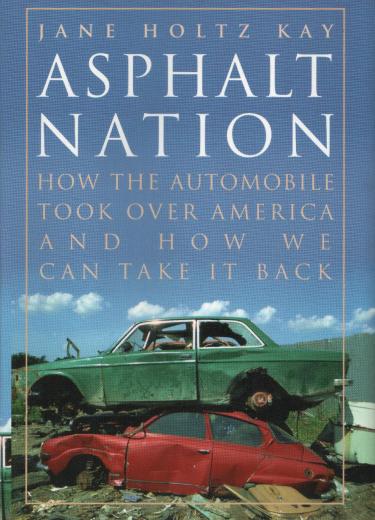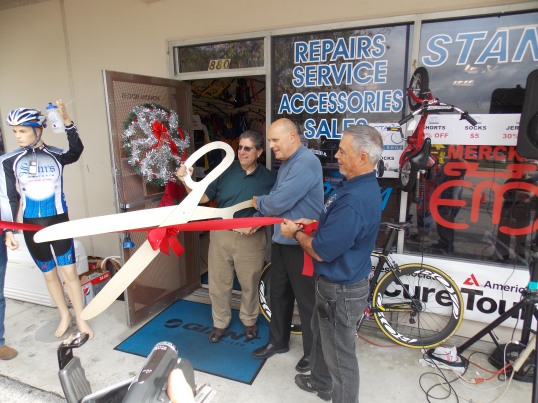
I first read Jane Holtz Kay’s wonderful book Asphalt Nation in the late 1990s, and it was one of the first books I’d read that systematically dissected the problems of the car-dependent culture.
Oh sure, growing up in Southern California, I knew firsthand about smog alerts, sig alerts, and oil spills, but, like so many American adolescents, I couldn’t wait for my 16th birthday and the California Driver’s License that signified freedom and the state’s semi official recognition of my nascent adulthood.
By the late 1990s, my growing concern over climate change and resource depletion got me thinking more critically about the automobile in our society (though I still drove a car pretty much everywhere), and prompted me to pick up her book and read it. It got me thinking for the first time about the centrality of the automobile to a wide range of issues, not just air pollution, but sprawl and the sacrifice of public transit and people-centered urban space to the car. It began an altering of my consciousness about the automobile that continues to this day.
Last week I was saddened to read of the passing of Jane Holtz Kay at the age of 74. Her New York Times obituary noted that she “felt like a voice crying in the wilderness,” and that people’s response to her book was either “so what?” or a belief that they were powerless to change things. As an advocate for alternative transportation, I certainly understand those frustrations, yet there was something else in the obituary that made me feel a sense that she was a kindred spirit, her own decision to give up her car and move to an apartment in Boston, within walking distance of public transit. “She was a big believer in doing things,” her sister told the New York Times. She lived her ideals, and she never quit trying to open people’s eyes to the necessity of shifting away from the car-centered culture if we are to live sustainably.
The notice of her passing prompted me to reread Asphalt Nation, and what is striking is how relevant it remains and how much it is not so much a voice in the wilderness as a voice ahead of its time. The book is well worth reading today, and I’d urge anyone who is interested in “taking back” America from the automobile juggernaut—or even creating pockets of walkability and bikeability—to read it.
Her book helps us to see that the problems associated with the automobile do not just revolve around tailpipe emissions (though those emissions are themselves a huge problem), but also have to do with other quality of life issues. Consider the freeway, the big box, the parking garage: all car-friendly/people-unfriendly places that will continue to dominate our landscape when everyone’s driving a hybrid. Consider the alienation and monotony of suburban sprawl, the sedentary life behind the wheel, the fast food “drive-thru” meal, and the obesity epidemic it engenders. Consider, too, the huge drain of car payments, insurance, and auto maintenance on the average family budget. None of these problems will be ameliorated by buying a Prius.
She saw the end of the age of the automobile as historian Frederick Jackson Turner had seen the end of the frontier in American History, the end of en era that had defined the nation, and the beginning of an era, she hoped, marked not by the desire for “escape,” but by “the cultivation of a landscape that values place more than passage, that restrains auto mobility in the name of human mobility, that re-thinks the way we live.” She hoped to create a “human and humane frontier” in the 21st century. (9)
She drew the veil away from many of the myths of automobility: that cars made us “free,” (they left us dependent on them and cost us extravagant amounts of money); that cars meant “progress,” (instead of destroying walkable communities and replacing them with “road-wrapped sprawl,” marked by its signature architectural monuments—the freeway and the big-box store in the middle of acres of asphalt parking lot.); and that they were simply a reflection of “free market” forces (instead of the massively subsidized system they are). But her book was more than just a litany of complaints about the automobile, it was also a window offering a glimpse of a way forward, where we might salvage our landscape and environment by shifting the focus from moving cars to moving people. This would mean reorienting our streets away from the car toward walking, bicycling and public transit.
She asked us, in short, to re-imagine our lives beyond the automobile:
Suppose we didn’t have pockets emptied by car costs and a world sullied by their toxins. Suppose we didn’t have traffic jams for the rich and cars on blocks and broken-down buses for the poor. Suppose we had an easier, fuller way to live. How better to live on traffic-calmed streets with grassy medians and leafed-over sidewalks, to stroll or bike down greenways, to traverse car-free Main Streets. It is time to create a living space for humans and a healthy planet habitat. It is essential to retrieve and absorb the walkable, bustling wonders of city life. (p. 357)
The movement to reclaim our culture from the automobile continues. Her passing merely reminds us that the task is yet unfinished. Like Jane Holtz Kay, we need to be believers in doing things to shift away from the car- and oil-dominated society.





